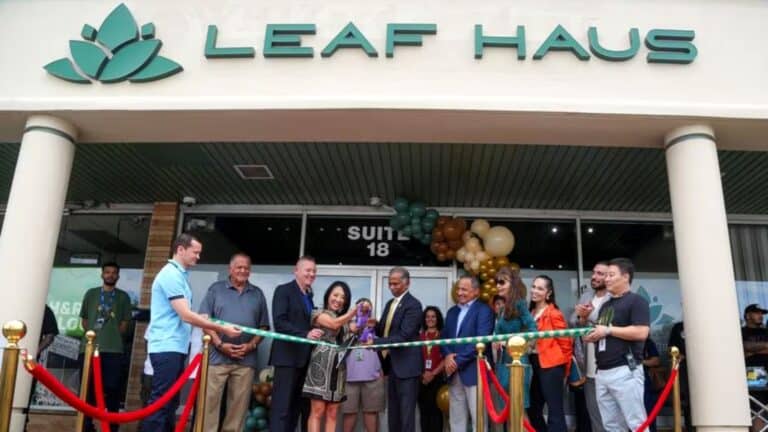Oregon Cannabis Connection
After a full week of legal marijuana sales to adults in Oregon, the numbers have completely blown Washington and Colorado out of the water! Even being the first to legalize, Colorado’s first week of $5 million dollars in sales paled in comparison to Oregon’s $11 million. And…Oregon has HALF the population of Colorado!
According to the Oregon Retail Cannabis Association, the state’s dispensaries sold an estimated 11 million dollars in cannabis the first week, equaling a quarter of what the state expected to be sold in an entire year. The state estimated tax revenues of only $9 million dollars for the entire year of 2017, which amounts to about 40 million in total sales statewide. By October 7th, just one week in, Oregon sales show just how badly they underestimated the popularity of cannabis.
“We’re seeing about 500 people a day,” Nectar owner Jeff Johnson told KGW TV in Portland, showing the huge numbers of people waiting to buy recreationally.
“There for awhile, towards the end we were thinking we might have to close the doors because we weren’t getting any kind of steady business,” Rachel Clerk, an employee at Fresh Buds, also told KGW.
With numbers like this, will communities that banned, or are thinking of bans, change their mind?Frustrated canna-businesses across the state hope so.
Ed Medina, owner of A Better Way Medicinal in Klamath Falls, a town that banned recreational sales, explained, “While lines are forming around the block at medical dispensaries that are allowed to sell recreational cannabis, we have seen a steady decline in our medical only sales.”
“In Klamath County, where businesses have closed recently, putting 100’s of people out of work, including the 2 Haggen’s stores, and where our schools and law enforcement are crying for funding, we have to turn away customers, and watch an entire industry flourish in other counties and cities around the state,” Medina told OCC. “It is incomprehensible as to why our local leaders could be so stubbornly stuck in old fashioned ways of thinking. My only hope is that they will open their eyes, see what’s happening in other counties, and change their minds.
Just how much could a city enacting a cannabis business ban stand to loose?
It’s hard to say, according to Anthony Johnson, the chief petitioner of Measure 91. “It depends upon how many licenses they could have issued,” he explained. “After July 1, 2017, tax revenue gets divvied up depending upon how many licenses a locality has within its jurisdiction.”
Another way to look at it is this: If Oregon were to continue with sales at just HALF the pace we have seen the first week, the state stands to make $65 million dollars the first full year of taxation. If there are 2,000 licenses issued for cannabis businesses in Oregon, then each license would be worth $32,500. If Klamath Falls had 40 licensees in their borders, they would stand to make $1.3 million in tax revenue. That’s a lot of money to leave on the table.
Another funding issue related to cannabis could be remedied by this surprise windfall of tax revenue…the current high fees on medical marijuana program participants.
A few years ago the Oregon Health Authority fees for the medical program increased by double, they stopped offering reduced fees to qualifying low income patients, and even added additional fees like a “change of grower” fee. Now that the state will likely have a massive surplus of tax revenue from the recreational market, the opportunity to remove the onerous fee structure they placed on patients is apparent, but patient advocates aren’t holding their breaths.
Anthony Tayor of Compassionate Oregon, one of the states leading patient advocacy groups, explained to OCC, “Prior to the start of early adult sales we advocated for dispensaries to set aside some of the revenue recreational sales generate to subsidize patient costs.”
“It would be wonderful if the legislature could come up with a scenario that would do just that,” Taylor added. “Unfortunately they are awfully fond of the extra revenue being generated by patients to advance such a plan.”
Clinics that have seen the higher fees the past few years understand what the patients experience. And, considering that adult sales would have never happened without the medical marijuana program, Keith McCann, the Executive Director of Compassion Center in Eugene, explained, “I believe the success of the medical program is what got this cannabis movement going here in Oregon.”
“We need to relieve the patients from the burden and expense of entering in to the ommp,” McCann explained further. “I can’t see any other justified reason not to, and with 11 million in revenue, it would be shameful not to give back to the medical patient community by making it affordable to obtain or renew your card.”
Oregon’s Advisory Committee on Medical Marijuana, or ACMM, advises the Oregon Health Authority on the fee structure every year, and they have long thought the fees were too high.
“We have always believed that the standard fee of $200 was too high for this self-supporting program,” explained Cheryl Smith, Chair of the ACMM. “In light of all the new income that is expected to be forthcoming from adult use cannabis taxation, it seems even more timely to bring the fee down to a reasonable sum.”
Should this coming windfall of cannabis tax money have been a big surprise in Salem? Probably not.
Legislators have had a hard time wrapping their minds around the number of people that use cannabis, and it’s an elusive figure, to be sure. But, during the campaign last year, ECONorthwest produced a report in July that estimated the tax revenue to be around 38 million the first year, or four times the amount the state’s very modest projections.
“Time will tell, but after the first week of cannabis sales amounted to $11 million, It certainly looks like ECONorthwest did a better projecting the revenue the cannabis industry will bring to Oregon than the state of Oregon did,” said Johnson, who was also the director of New Approach Oregon, the organization that handled the campaign. “Determining how many people would utilize the regulated market was a relatively hard variable to predict, but it looks like the extensive research done by ECONorthwest paid dividends and their projections are looking solid at this moment.”
As Oregon moves forward, a more open mind towards cannabis may be in order. The revenues that were generated week one shows the number of people that are cannabis users and the amount of money being left on the table by communities that refuse to participate in something that is more and more common and acceptable. It’s not just the sick who receive benefits or get enjoyment from cannabis, it’s everyday people you know and admire, too.
If you really delve down, you will find doctors, teachers, judges, athletes, moms, grandmas, granddads, politicians, lawyers (of course!), business people, laborers, immigrants, your Uncle Frank, and even Aunt Millie, who goes to church every Sunday and Wednesday and who thinks Ronald Reagan was the last great hope for America! Those are the ones who have benefited and enjoyed cannabis, very quietly, for years, and are now able to simply enjoy cannabis for the fun, and I dare say recreational aspect, and do it legally in Oregon!
Source: Oregon Cannabis Connection - make sure to check them out, they have TONS of great stuff on their site and in their print publication!!!










